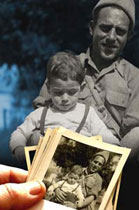
Bet Herut: The End of the Beginning 2003
Distributed by Cinema Guild, 115 West 30th Street, Suite 800, New York, NY 10001; 212-685-6242
Produced by Eran Preiss and K. M. Winikur
Directed by Eran Preiss and K. M. Winikur
VHS, color, 53 min.
College - Adult
Middle Eastern Studies, Israel
Date Entered: 11/22/2005
Reviewed by Sheila Intner, Professor, Graduate School of Library & Information Science, Simmons College GSLIS at Mt. Holyoke, South Hadley, MAThree compelling stories unfold here: the history of Bet Herut, an Israeli moshav founded and populated largely by American immigrants, and a case study of the Israeli experiment in communal farming and living; the story of Nachi Ariel, Bet Herut’s founder; and the story of filmmaker Eran Preiss. [Note: a moshav is a cooperative community in which members may receive salaries and own property, unlike a kibbutz, in which money and property are communally owned. Moshavs are democratically governed, like kibbutzes.]
Nachi Ariel, founder and charismatic leader of Bet Herut, dreamed of settling the land and making it bloom through hard work and dedication to the community. Filmmaker Preiss grew up at Bet Herut idolizing him. The first story, told through interviews, archival film clips, and photographs, follows Bet Herut’s growth: farming, running a summer camp, raising poultry, opening a meat processing plant, and mounting acclaimed holiday theatricals. The fat years lasted for decades into the 1980s. Then, Nachi died. In the ensuing decades, members’ dedication to the community waned and they took private work even as they collected their salaries. More and more had to take jobs outside the moshav as the moshav’s enterprises languished, burdened with high costs, increased competition, and a changing economy. With bankruptcy looming, we watch a final vote to close the moshav, lay off its remaining workers, and dispose of its assets.
Throughout Bet Herut’s history and development, Nachi Ariel was the anchor. But after he died, no one would talk about him. Years later, Preiss teases out the reason, piecing it together with the help of one of Nachi’s daughters and numerous moshav senior citizens. Realizing one night as he stood guard duty with his Uzi that he hasn’t long to live and will leave behind his son and daughter-in-law, both retarded, Nachi excuses himself, goes to his son’s home, shoots and kills the couple, and turns the gun on himself. Peers muse, “Why couldn’t he trust us to take care of them?”―but it is too late for the answer.
The final story is the filmmaker’s own. When his mother fell ill and the family moved to Beersheba, Eran Preiss felt himself uprooted from the home he loved. After her death, when Eran was in the army, his father remarried and distanced himself from all but his two youngest daughters. Eran and two other sisters were no longer permitted to live with them as a family. The bitterness of these choices haunts the film to its end.
Given the riveting stories it tells, this piece deserves better technical treatment. On the upside, the English subtitles are the best I’ve ever seen and the camerawork is splendid. But the downside requires adding reservations to my recommendation. The screen is constantly going to black and viewers must work too hard to interpret a badly stitched collage of images, narrative, live action scenes, and archival documents. Recommended, with reservations.